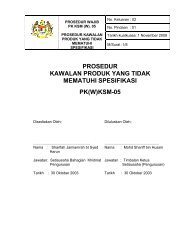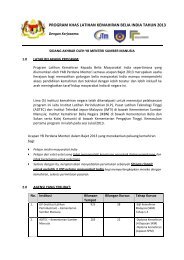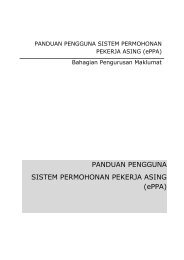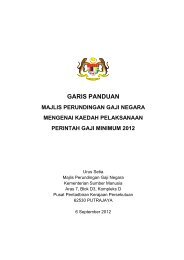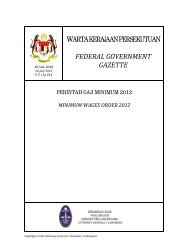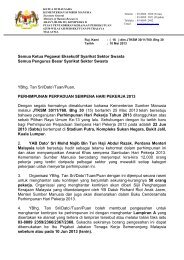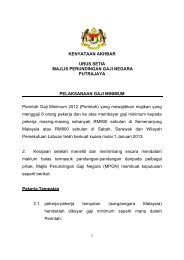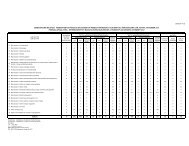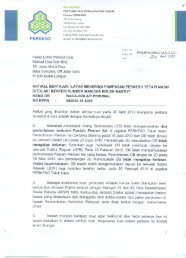BULETINKSM - Kementerian Sumber Manusia
BULETINKSM - Kementerian Sumber Manusia
BULETINKSM - Kementerian Sumber Manusia
- No tags were found...
You also want an ePaper? Increase the reach of your titles
YUMPU automatically turns print PDFs into web optimized ePapers that Google loves.
1632 J. Am. Chem. Soc., Vol. 123, No. 8, 2001 Boring et al.Scheme 1. Mechanism for O 2 -Based Oxidation ofThioethers Catalyzed by Au(III)Cl 2 NO 3 (thioether) (1)there is only 1 equiv of NO 3 - in our reactions, yet most ofthem have been taken to 30 or more turnovers and in one case200 turnovers (200 equiv of CEESO product per equivalent ofAu and equivalent of NO 3 - ). Figures 4 and 5 indicate that thekinetically dominant species leading to CEESO contains Au,Cl - , and NO 3 - in a 1:2:1 ratio, and Figure 6 indicates that thisspecies also contains CEES (Figure 6 is addressed furtherbelow). Dimeric or oligomeric d 8 square-planar Au(III) are notparticularly common, 30 and a monomeric Au(III) complex withtwo Cl - ligands, one NO 3 - ligand, and at least one CEES ligandis likely. While 5-coordinate Au(III) complexes cannot berigorously ruled out, they are not likely to be significant. 71 Allthe information on oxidation of thioethers by Au(III) complexesis consistent with the rapid exchange of all ligands on Au(III)prior to thioether oxidation. 32-36 For the present catalytic system,these preequilibria are summarized by eqs 4 and 5 in Scheme1. Explicitly, Cl - ,NO 3 - , and CEES lead to formation of theAu(III) complexes required for CEESO formation: a complexwith one CEES ligand (henceforth 1), with formation constantK 1 , and a complex with two CEES ligands (henceforth 2), withformation constant K 2 . These ligands drive eq 4 to the right.H 2 O (data in Figure 7), and the CEESO product, modeled byanother sulfoxide, DMSO (data in Table 1), both inhibit therate of reaction by decreasing the concentrations of the Au(III)complexes required for CEESO formation. These ligands driveeq 4 to the left. For completeness, CH 3 CN may also competitivelybind to Au(III), but this cannot be assessed since it is thesolvent.(71) The only 5-coordinate Au(III) complexes with appreciable stabilitycontain chelating ligands such as bromodicyano(1,10-phenanthroline)-gold(III) isolated from dimethylformamide: Marangoni, G.; Pitteri, B.;Bertolasi, Y.; Gilli, G.; Ferretti, V. J. Chem. Soc., Dalton Trans. 1986,1941. If there is an interaction between a positive Au(III) center and anegative axial ligand counterion, this ligand would likely be Cl - , becauseNO 3 - associates very weakly with Au(III) (and not at all with Au(I).Literature studies of thioether-Au(III) reactions establish thatAu(III) complexes with one thioether ligand, such as 1, areconsiderably more abundant in solutions of excess thioether thancomplexes with two thioether ligands, such as 2 (K 1 . K 2 ). 35,36No Au(III) complex with three thioether ligands is given inScheme 1 because there are no data indicating these speciesform in measurable quantities (i.e., K 2 . K 3 ; K 3 ∼ 0). Evaluationof the kinetics data below also indicates that 1 and not 2 is thekinetically dominant Au(III) complex for catalytic aerobicoxidation of CEES to CEESO.Three lines of evidence establish that the redox step, oxidationof thioether/reduction of Au(III), eq 6 in Scheme 1, is ratelimiting in the catalytic O 2 -based oxidation of thioethers: First,all the rate information (Figures 4-8) are consistent with this;second, the rate is independent of O 2 pressure, and third, Au(III),not Au(I), is the dominant form of Au during catalytic turnover.The rate constants k 1 and k 2 in eq 6 are for 1 and 2, respectively;however, eq 6 has been written in terms of 1 and its redoxproducts, (CEES)Au I Cl (3), Cl - , and NO 3 - (versus 2 and itsproducts), because most of the observed chemistry derives from1. Because eq 6 is clearly rate determining, the subsequent steps,eqs 7 and 8, are not.There are several possible mechanisms for the rate-limitingredox step, eq 6, but one is more consistent with the data,analysis of the data below, and the stoichiometric Au(III)-thioether studies in the literature. First, a mechanism involvingrate-limiting formation of the required Au(III) complex (primarily1 in our case) prior to redox chemistry is not compatiblewith any of the literature studies, nor is it compatible with thekinetic requirement of two molecules of thioether in the slowstep. The detailed equilibrium and kinetics studies (extensivedata and fitting) of two groups establish that two moleculesof thioether are involved in the slow step: Natile and coworkers36 on the oxidation of a Me 2 S, Et 2 S, and n-Pr 2 SbyAu(III)(Cl) x (RS) 4-x and Elding and co-workers 35 on the oxidationof a Me 2 Sbytrans-Au(III)(CN) 2 (Cl) 2-x (RS) 2-x . While theNatile system and ours differ in three ways, theirs does notundergo catalytic turnover, does not contain NO 3- , and is in95:5 CH 3 OH/H 2 O (versus CH 3 CN in our case), the Au(III)-thioether coordination and redox chemistry in the two systemsare otherwise very similar. Elding’s complex, while not as closeto ours as that of Natile, nonetheless shares structural and redoxchemistry very similar to ours as well.A second possible mechanism is an intramolecular decompositionof the required Au(III) complex, eqs 9 and 10.k1intra198 Cl-Au I -CH 3 CN + CEES + --Cl + NO 3This is effectively a rate-limiting reductive elimination to forma thioxonium salt (whose fate, eq 7 in Scheme 1, is addressedbelow) and a Au(I) complex. While this mechanism has beenproposed for some thioether oxidations by Au(III), 32,34,35 it islikely not operable in our catalytic aerobic oxidation chemistry.First, eq 9 is not compatible with the finding that two moleculesof thioether are involved in the rate-limiting redox step (videsupra). 35,36 However, this argument does not eliminate eq 10,which involves two thioether molecules. The conversion of 2to 3 + CEESO can, in principle, be assisted by H 2 O, eq 11, 35(9)k2intra298 Cl-Au I -CEES + CEES + -Cl (10)298H 2 O Cl-AuI -CEES + CEESO + HCl (11)



